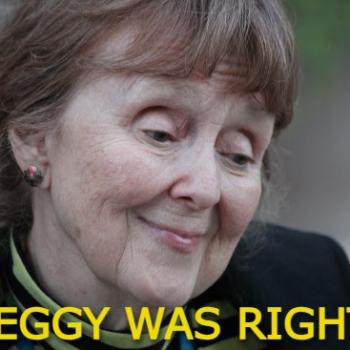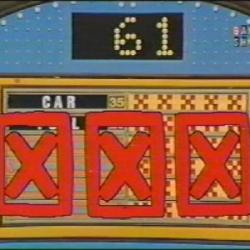David Crary of the Associated Press has a helpful round-up of marriage equality politics in several states: Maryland, New Jersey, Washington, Maine, New Hampshire, North Carolina and Minnesota. The first four there are hopeful stories, the latter three are cause for concern (in the short run, at least).
Crary’s piece drew the attention of Christianity Today’s Politics Blog. That’s not surprising, since CT’s readership is the evangelical subculture for whom marriage equality has been a headline-grabbing obsession for the past decade.
But Sarah Pulliam-Bailey’s post is remarkable for its matter-of-factness. That amounts to a subtle shift.
I used the words “hopeful” and “cause for concern” above to characterize the state of marriage equality in the states. That’s how I regard the news that Crary reports. Some of it is Good News, and some of it is Bad News.
Usually when we talk about the myth of perfect “objectivity” in journalism — what Jay Rosen calls the “view from nowhere” — we’re talking about partisan politics. But the truth is that almost all news is conveyed as either Good News or Bad News. And most of that news has nothing to do with politics, partisan disputes or politicized controversies. “Objectivity” in reporting such news is neither possible nor desirable.
Look at a newspaper (quick! — while you still can). Much of the stuff in there each day isn’t political. A big chunk of the paper every day is filled with car-crashes, traffic jams, house fires, crimes and community events. Family of three displaced by fire. Police accuse man in string of robberies. Woman dies after accident. Students’ carnival funds trip for marching band. That sort of thing.
Reporting on those stories is never objective and no one would want it to be. It would be weirdly inhuman to treat stories like that objectively. The house fire is Bad News, but the family’s safe escape is Good News. The robberies are Bad News, but the arrest of a suspect is Good News. The fatal car crash is Bad News. The students’ successful fundraiser is Good News.
Any report that “objectively” ignored the badness and goodness of the news in such matters wouldn’t come across as “fair and balanced,” but as off-putting and strange. A report on a house fire that didn’t frame the incident as an unfortunate, undesirable event wouldn’t seem “objective,” it would just make the reader think that there was something weirdly wrong with the reporter who wrote it.
That implicit framing has usually been the norm for reporting on marriage equality in the evangelical press. CT’s posts and articles on the subject have usually treated any advance toward marriage equality as an implicit defeat — as Bad News. But that framing doesn’t shape Bailey’s recent post.
This is news. That CT is reporting such news without explicitly framing it as Bad News is, I think, Good News.
The post concludes with this sentence:
Rep. Barney Frank’s office said that the retiring 71-year-old Democrat from Massachusetts will marry his longtime partner in Massachusetts.
That’s offered as one more relevant data-point in a roundup of recent news on the topic. It’s not lamented or subtly recoiled at, or positioned as further evidence of America’s moral decline. It’s just, “Oh, and Barney Frank is getting married” with no further comment.
This is a familiar sort of news to anyone accustomed to reading newspapers. It’s a wedding announcement. Newspaper-readers know how to read a wedding announcement.
A wedding announcement is always a Good News story. We may not know or care about the couple involved as we flip through the pages of the paper or scroll past the articles on the screen, but such stories always inevitably register as Good News. It’s very hard to think of them otherwise. A wedding story is always a check in the plus column, informing us of an increase in the total stock of human happiness. We mentally file such news on the opposite side of the ledger from all those stories of car-crashes and house fires and crimes. It gets listed alongside that story about the school carnival, or the one about the local church’s sesquicentennial or the opening of that new business on Main Street.
And that long habit — well-established and utterly sensible — is bound, increasingly, to be the frame that shapes news coverage of marriage equality. It will shape how stories are reported and how they will be read. Good News — a happy couple is getting married.
Crary’s article clearly outlines the many ways in which marriage equality is also still a partisan political controversy. Reporters who approach it as such will, rightly, try to provide balanced coverage that fairly represents both sides of that partisan political dispute. And readers predisposed toward one side or the other in this dispute are bound to approach every such story by viewing it through the lens of a victory or a defeat for their side. And that political controversy framing won’t be going away any time soon.
But at the same time, that framing is constantly being undermined by the unambiguously happy news of wedding announcements. There’s no on-the-other-hand opposing point of view to such happiness that can hold itself up as the equivalent other side of the story. It just doesn’t work.
Here is a happy couple celebrating their wedding. But, on the other hand, here is someone who resents their happiness and would legally forbid it if they could. Even if the reporter is vehemently opposed to marriage equality, and even if the report is being read by readers who share that vehement opposition, that just doesn’t work. The happiness and celebration will still register, on some level, as Good News. And the opposing view will thus register, on some level, as “opponents insist that Good News is Bad News.” Those two things just can’t be convincingly “balanced” against one another.












